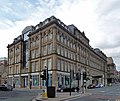William Parnell (architect)
William Parnell | |
|---|---|
| Born | William B. Parnell |
| Died | 1886[1] |
| Occupation | Architect |
| Years active | Mid–late 19th century |
| Notable work | Tyne Theatre and Opera House |
William B. Parnell (d. Croydon, 1886) was an architect active in the 19th century particularly in Newcastle upon Tyne, England. A number of his works on Newcastle Quayside near the then future location of the Tyne Bridge were built following the Great fire of Newcastle and Gateshead in 1854.[2] Noted architect Frank West Rich served as an apprentice under Parnell.[3]
Parnell trained under Edward I'Anson in London before relocating to Newcastle upon Tyne.[4] In Newcastle upon Tyne he was located at 21 Collingwood Street.[5]
Parnell's Tyne Theatre and Opera House operates to this day. Parnell architected Phoenix House that was built for Royal Insurance. Shipping company Nielsen, Andersen & Company had operated out of offices within some of the buildings that Parnell architected on King and Queen Streets on Newcastle Quayside.
Noted works in Newcastle upon Tyne
[edit]- St Nicholas' Buildings, St Nicholas Street (1850), Grade II listed building[6]
- Exchange Buildings, King Street (1862), Grade II listed building[7]
- Princes Buildings, 1–23 (odd numbers) Queen Street (1863), Grade II listed building[8]
- Tyne Theatre and Opera House (1867), Grade I listed building[1]
- Phoenix House, Sandhill (c. 1869, built for Royal Insurance), Grade II listed building[9]
-
Tyne Theatre and Opera House
-
Princes Buildings, Queen Street
-
Phoenix House, Sandhill
-
Exchange Buildings, King Street
-
St Nicholas Buildings, St Nicholas Street
References
[edit]- ^ a b "Tribute to Tyne Theatre Architect; the Man Responsible for the Tyne Theatre Has Been Saved from Anonymity. Tony Henderson Looks at a Fitting Tribute to One of Tyneside's Forgotten Heroes". The Journal. Newcastle upon Tyne. 22 November 2007.
- ^ Pevsner, Nikolaus; Grundy, John; Ryder, Peter; McCombie, Grace; Welfare, Humphrey (11 March 1992). Northumberland. Yale University Press. ISBN 978-0-300-09638-5. Retrieved 7 July 2021.
- ^ "William Parnell". Co-Curate. Newcastle University. Retrieved 7 July 2021.
- ^ Brodie, Antonia; Library, British Architectural; Architects, Royal Institute of British (20 December 2001). Directory of British Architects, 1834-1914: Vol. 2 (L-Z). A&C Black. p. 321. ISBN 978-0-8264-5514-7. Retrieved 7 July 2021.
- ^ "To Builders and Contractors". The Journal. Newcastle upon Tyne. 16 August 1865.
- ^ "ST NICHOLAS' BUILDINGS, Non Civil Parish - 1024772". Historic England. Retrieved 7 July 2021.
- ^ "EXCHANGE BUILDINGS, Non Civil Parish - 1355283". Historic England. Retrieved 7 July 2021.
- ^ Robson, Ian (28 July 2017). "First look inside luxury apartments on Newcastle's quayside". ChronicleLive. Retrieved 6 July 2021.
- ^ "Newcastle, Sandhill, No. 18 (Phoenix House)". Sitelines. Newcastle City Council. 26 May 2021. Retrieved 7 July 2021.





